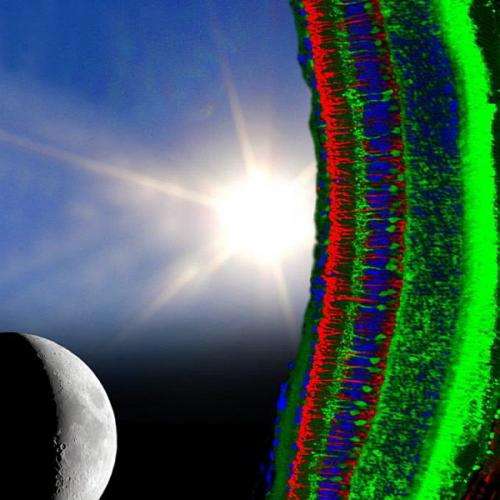Simulating new treatment for retinal degeneration

For a few years now optogenetics has been seen as a very promising therapy for progressive blindness, for example when it is a result of retinal degeneration. In order to further develop this therapeutic approach, Marion Mutter and project leader Dr. Thomas Münch of the Werner Reichardt Centre for Integrative Neuroscience (CIN) and the Bernstein Center for Computational Neuroscience (BCCN) at the University of Tübingen have developed a computer model that simulates optogenetic vision. The research has been published in the November 27 issue of PLOS ONE.
Retinitis Pigmentosa is a form of retinal degeneration in which the photoreceptors in the eye die off. In order to counteract the accompanying loss of light perception, light-sensitive proteins known as channelrhodopsins are introduced into the retina using an optogenetic procedure. Every cell that contains channelrhodopsins can be activated by exposure to light. After optogenetic treatment, neighboring cells can take over the lost functions of the photoreceptors. This procedure has already been successful in restoring vision in mice. Thus, in the last few years, the foundation has been laid for using optogenetics to treat blindness.
However, the method has its limits. Human vision normally deals well with extreme contrasts of light levels in the environment – we are able to see in anything from weak starlight to glaring sunshine. In contrast, 'optogenetic vision' with channelrhodopsins would only work in the very brightest sunlight – at least with the variants of channelrhodopsin that have been developed so far.
Improving the characteristics of channelrhodopsins is something to be hoped for, above all from the point of view of developing potential future applications in humans. The researchers developed and used a computer model to investigate how to achieve these improvements. This model makes it possible to assess how well different variants of channelrhodopsin would support restoring a sense of vision. "When one of these molecules is activated by light, it cycles through a defined set of states which ultimately determine the light response of the treated eye," explains Marion Mutter. Previously, improvements to channelrhodopsin were mainly pursued to carry out research into basic neurobiological questions. "Our results show that optogenetic vision would benefit from completely different improvements which have so far been overlooked," Marion Mutter and Thomas Münch say.
What effects would these improvements have on the sense of vision? "According to our calculations, it should be possible to see in brightness conditions that are one hundred times dimmer than what would currently be possible," explains Thomas Münch. According to his estimates, this would allow patients treated with optogenetic techniques to be able to see not only in sunlight, but also in a well-lit room. "At these brightness levels we reach the biophysical limits of what is possible with classic channelrhodopsin molecules," says Münch. "However, in our study we could also show why there are these limits, and so we provide a direction for novel types of improvements in the future."
More information: Marion Mutter & Thomas A. Münch (2013): Strategies for expanding the operational range of channelrhodopsin in optogenetic vision. PLOS ONE, DOI: 10.1371/journal.pone.0081278




















